AWS Business Intelligence Blog
Enhanced table navigation: Freeze/unfreeze Table Columns in Amazon QuickSight
 |
All your trusted BI capabilities of Amazon QuickSight now come with powerful new AI features that integrate chat agents, deep research, and automation in one seamless experience with Amazon Quick Suite! Learn more » |
Amazon QuickSight is a fully managed, scalable business intelligence (BI) service provided by Amazon Web Services (AWS). It is designed to make it easy for all users to build visualizations, perform ad hoc analysis, and quickly get business insights from their data. QuickSight seamlessly connects with various AWS data sources. With its user-friendly interface and robust analytics capabilities, it enables professionals across different organizational levels to create and publish interactive dashboards, making data-driven decisions more accessible and efficient.
We are excited to introduce the latest feature in QuickSight that gives authors and readers the ability to freeze columns within tables. This new functionality brings a whole new level of control and convenience for analyzing data in tables. Now, with just a few clicks, you can lock specific columns in place, ensuring that essential information remains visible while scrolling horizontally across wide tables. No more losing sight of critical data points or headers as you explore your tables. This enhancement to the already robust suite of tools in QuickSight aligns with our commitment to delivering a more intuitive and responsive user experience.
In this post, we demonstrate how to freeze columns for enhanced table navigation in QuickSight.
Overview of column freeze in QuickSight
Freeze refers to the ability to affix a specific column in place (also known as freezing columns) while scrolling horizontally across a table. As you navigate through the data, the frozen column maintains its fixed placement on the left, persistently remaining visible and accessible. This offers you an uninterrupted view of essential columns, making it easier to maintain context and navigate across extensive datasets.
Furthermore, you can fix the positions of multiple adjacent and consecutive columns simultaneously as you scroll through the table using ‘Freeze upto this column’. These columns act as a cohesive unit, remaining visible on the page regardless of horizontal scrolling. This enables you to have a constant reference point for key data or information, facilitating ease of exploration and interaction with other parts of the table.
|
In the words of one of our customers, NFL Next Gen Stats:
|
Column freezing in QuickSight offers four options: Freeze column, Freeze up to this column, Unfreeze column, and Unfreeze all columns. These can be accessed through the header’s contextual menu for the chosen column.

In the following sections, we demonstrate how to use these options and further customize your view in QuickSight.
Freeze a single column
In the following example, we freeze the second column Industry.
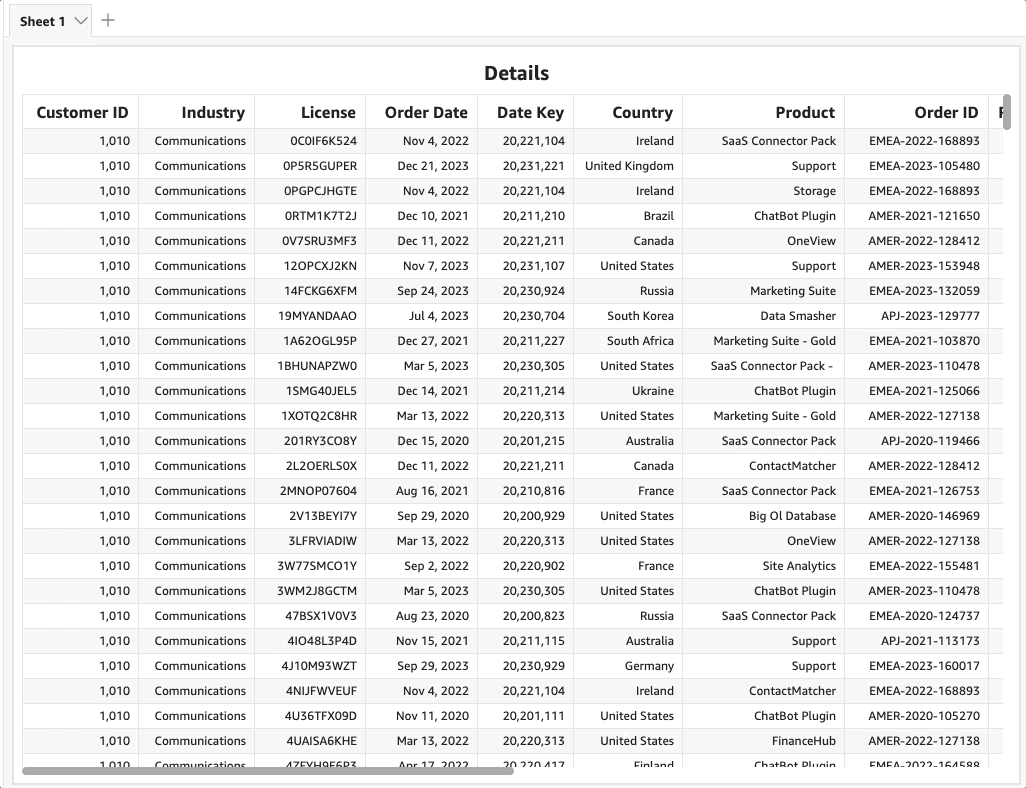
Choose the column’s header and then choose Freeze column on the drop-down menu. After it’s frozen, it automatically becomes the first column of the table. When scrolling horizontally, this frozen column will always stay visible until you unfreeze it.
If you want to freeze multiple columns, one option is to do so by freezing them one by one. Any additional column you freeze will always go to the right of the last previously frozen column.
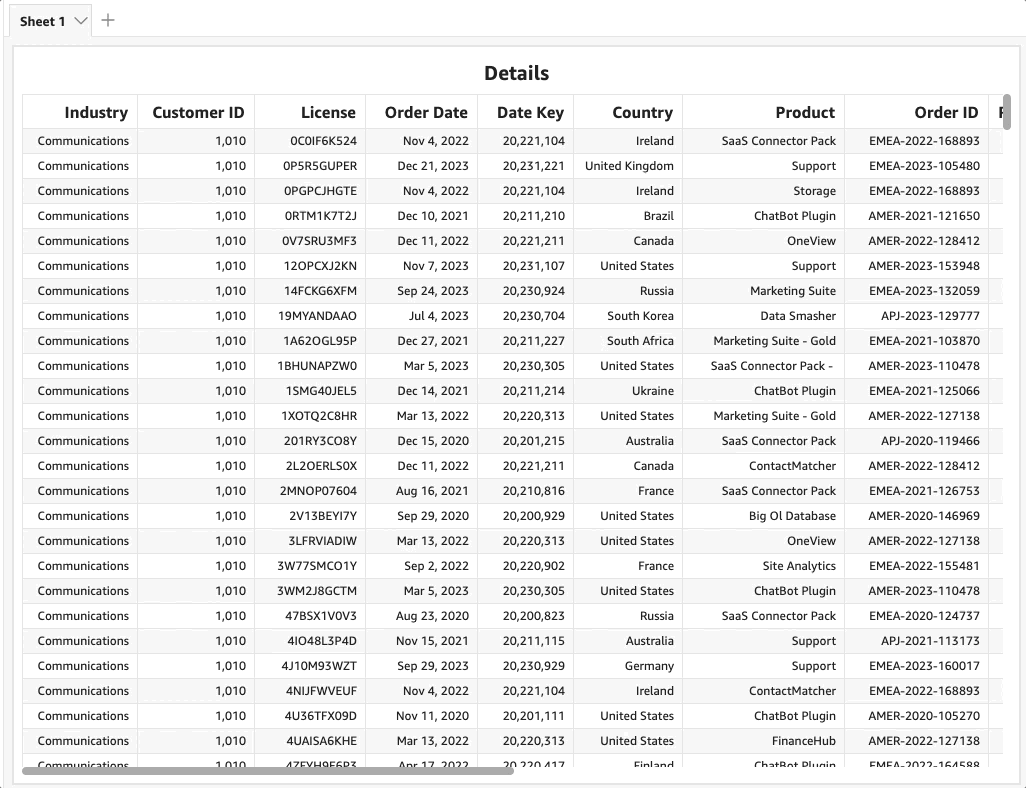
Reorder frozen columns
Rearranging columns is not limited to the frozen columns only. All columns within the table can be reordered. However, for frozen columns, adjustments are limited to the frozen panel, and for unfrozen columns, changes occur outside the frozen sections. To rearrange frozen columns, choose the column’s header, choose Move, and choose the right or left arrows.
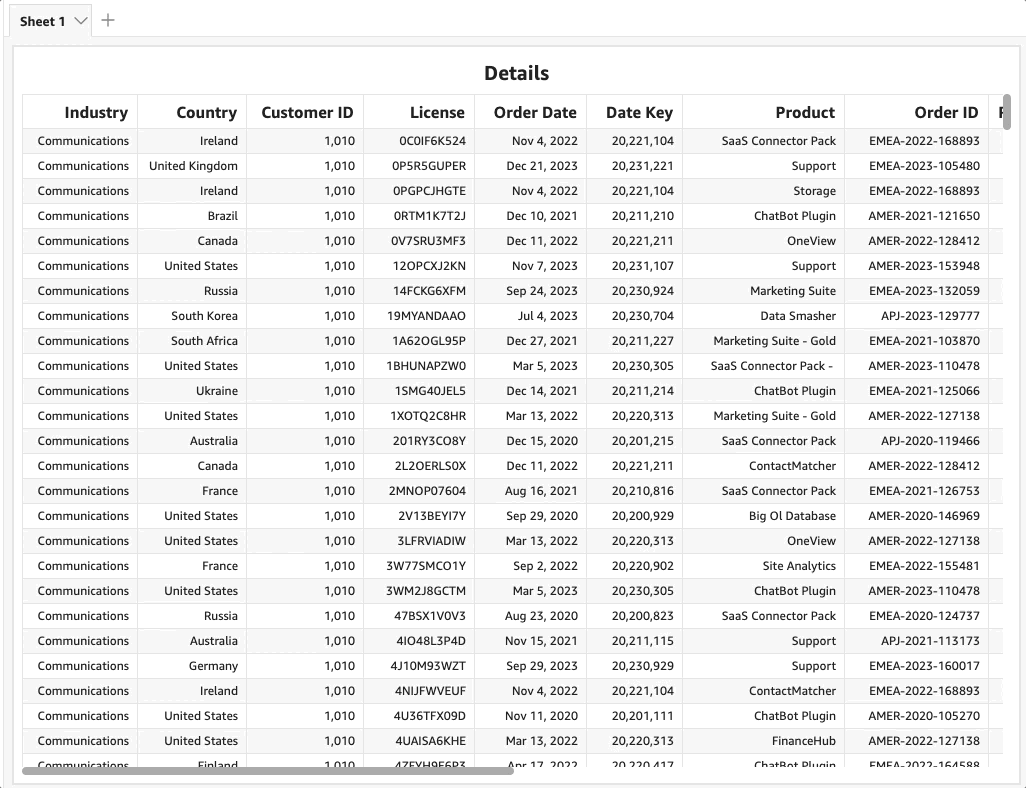
In our example, we have two frozen columns, Industry and Country. We can move Industry to the right of Country or we can move Country to the left of Industry. However, we can’t move them outside of the frozen panel. This means that the first column outside the frozen pane, Customer ID, can be moved anywhere to the right, but not to the left (unless we freeze it first).
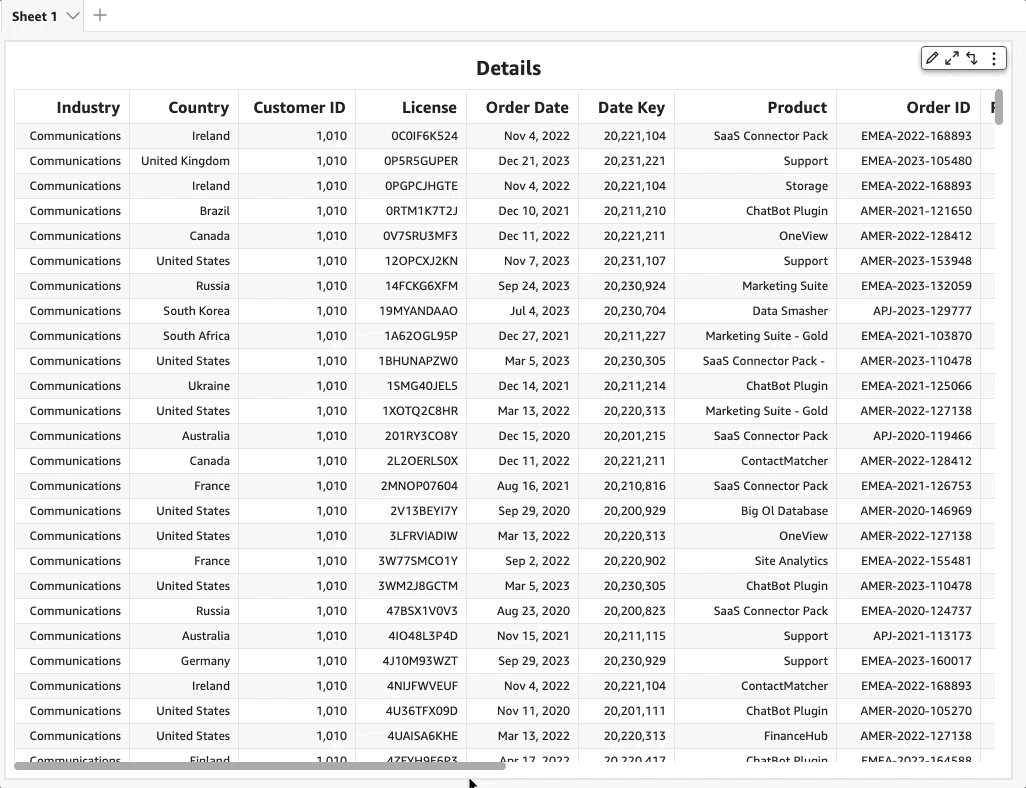
Freeze multiple, adjacent columns
Rather than freezing columns one by one, you can use the Freeze up to this column option to freeze consecutive columns with a single click. This feature freezes a block of consecutive columns, including the columns already frozen(if any), starting from the very first column and extending to the selected endpoint, into a unified panel that behaves as one.
To implement this, identify the column where you want the table view to freeze, choose its header, and choose Freeze up to this column on the drop-down menu. In our example, we’ve selected Order Date, the fifth column from the left. This action will lock the initial five columns together, ensuring their persistent visibility while scrolling horizontally.
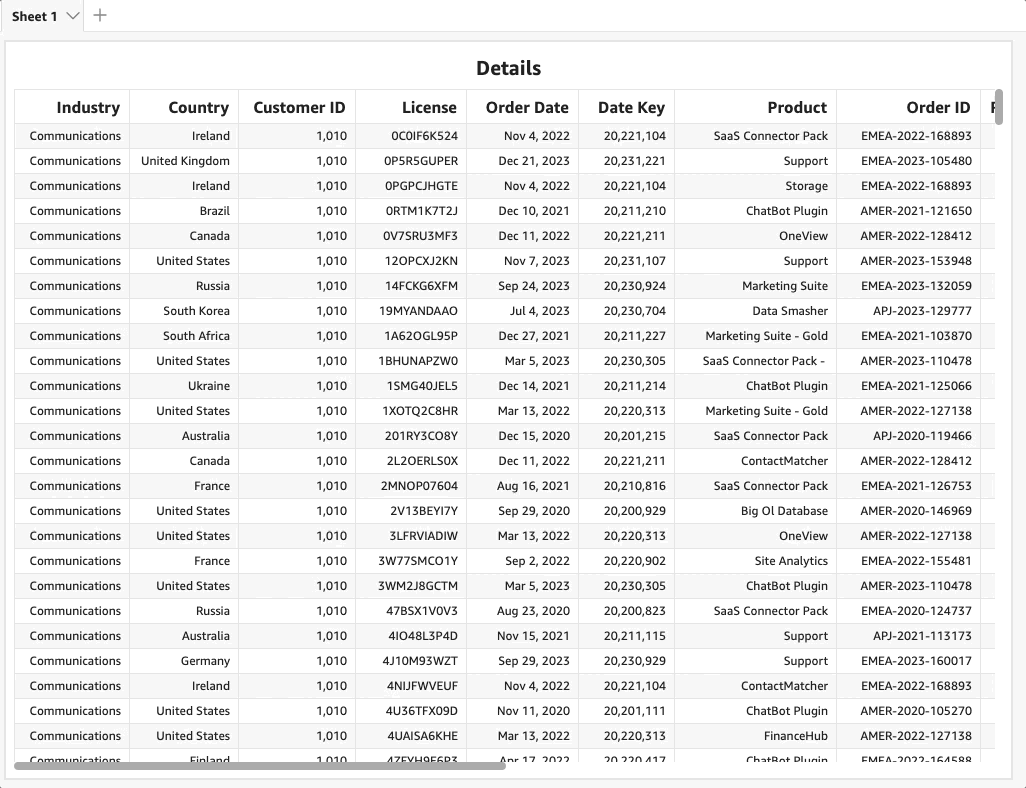
Unfreeze a single column
An unpinned column refers to a column within a table that is not affixed or anchored in a fixed position. Unlike frozen columns that remain visible as you scroll horizontally, unfrozen columns move along with the scroll, allowing you to navigate through the data freely. To unfreeze a column from the set of frozen columns, choose the header of the column you want to unfreeze and choose Unfreeze column. In the following example, we unfreeze the third column, Customer ID.
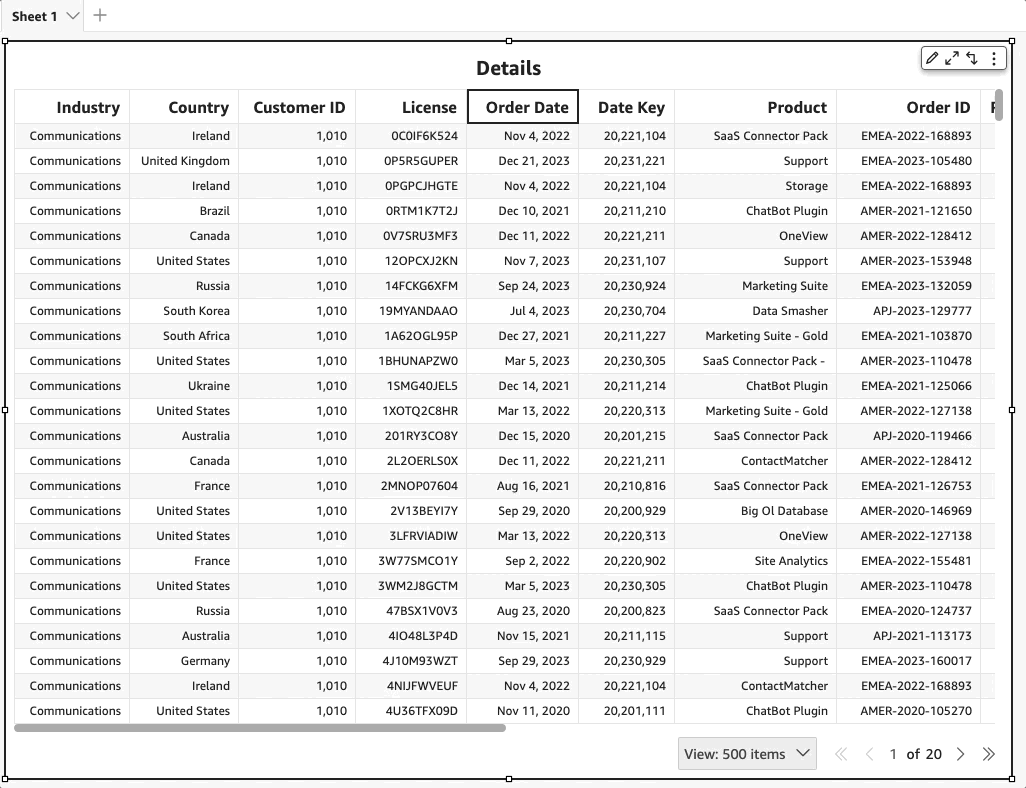
Unfreeze all columns
A convenient way to unfreeze all columns at once is to choose Unfreeze all columns on the drop-down menu of any frozen column’s header. This action restores all columns to their original order and position in the table.

Conclusion
Along with the other newly introduced table and pivot table enhancements, the introduction of freeze columns in QuickSight marks a substantial advancement in our dedication to enhancing user engagement with data. By empowering both authors and readers with precise control over their table navigation, this feature elevates the data exploration process, making it more intuitive and tailored to individual needs.
Whether you are an author aiming to provide consistent visualization or a reader seeking to customize your view, the column freeze functionality offers a refined and responsive approach to data analysis. From simple clicks to lock specific columns to freezing multiple columns, these enhancements are designed to improve your data interaction experience. You can craft tailored views that unlock insights, avoid losing context, and enhance interpretation of large, complex data.
We invite you to explore this innovative feature and experience firsthand how it can transform your ability to navigate and interpret large datasets. Your feedback is invaluable to us, and we remain committed to continuous innovation and excellence in QuickSight, aligning with our mission to make data-driven decision-making more accessible and efficient for everyone.
Dive into the new freeze columns feature in QuickSight today and witness how it empowers you to navigate and interpret expansive datasets effortlessly!
About the authors
 Bhupinder Chadha is a senior product manager for Amazon QuickSight focused on visualization and front end experiences. He is passionate about BI, data visualization and low-code/no-code experiences. Prior to QuickSight he was the lead product manager for Inforiver, responsible for building a enterprise BI product from ground up. Bhupinder started his career in presales, followed by a small gig in consulting and then PM for xViz, an add on visualization product.
Bhupinder Chadha is a senior product manager for Amazon QuickSight focused on visualization and front end experiences. He is passionate about BI, data visualization and low-code/no-code experiences. Prior to QuickSight he was the lead product manager for Inforiver, responsible for building a enterprise BI product from ground up. Bhupinder started his career in presales, followed by a small gig in consulting and then PM for xViz, an add on visualization product.
 Gilbert V Lepadatu is a QuickSight Sr. Specialist Solution Architect. With experience in two Fortune 100 companies, he has spearheaded data science, analytics, and automation initiatives, achieving significant revenue growth and operational efficiencies. Leveraging a PhD in Philosophy and two masters’ degrees, Gilbert has also contributed to academia, teaching classes on statistics and data visualization. His diverse skill set encompasses AWS services, data visualization, data science and analytics, machine learning and communication across technical levels.
Gilbert V Lepadatu is a QuickSight Sr. Specialist Solution Architect. With experience in two Fortune 100 companies, he has spearheaded data science, analytics, and automation initiatives, achieving significant revenue growth and operational efficiencies. Leveraging a PhD in Philosophy and two masters’ degrees, Gilbert has also contributed to academia, teaching classes on statistics and data visualization. His diverse skill set encompasses AWS services, data visualization, data science and analytics, machine learning and communication across technical levels.
 “Over the years, as our usage of Next Gen Stats has expanded, the number of metrics we want to analyze in a single table has also grown significantly. This resulted in very wide tables that were difficult to interpret. With the new ability to freeze key contextual columns like player name, team, and position group while scrolling horizontally, our dashboard users can now easily view player stats tables containing a large number of metrics. By freezing the vital context fields on the left, users can freely scroll right to compare any metrics without losing sight of what each row represents. This enables much more effective analysis and insights extraction from the wealth of Next Gen Stats data now available to us.”
“Over the years, as our usage of Next Gen Stats has expanded, the number of metrics we want to analyze in a single table has also grown significantly. This resulted in very wide tables that were difficult to interpret. With the new ability to freeze key contextual columns like player name, team, and position group while scrolling horizontally, our dashboard users can now easily view player stats tables containing a large number of metrics. By freezing the vital context fields on the left, users can freely scroll right to compare any metrics without losing sight of what each row represents. This enables much more effective analysis and insights extraction from the wealth of Next Gen Stats data now available to us.”